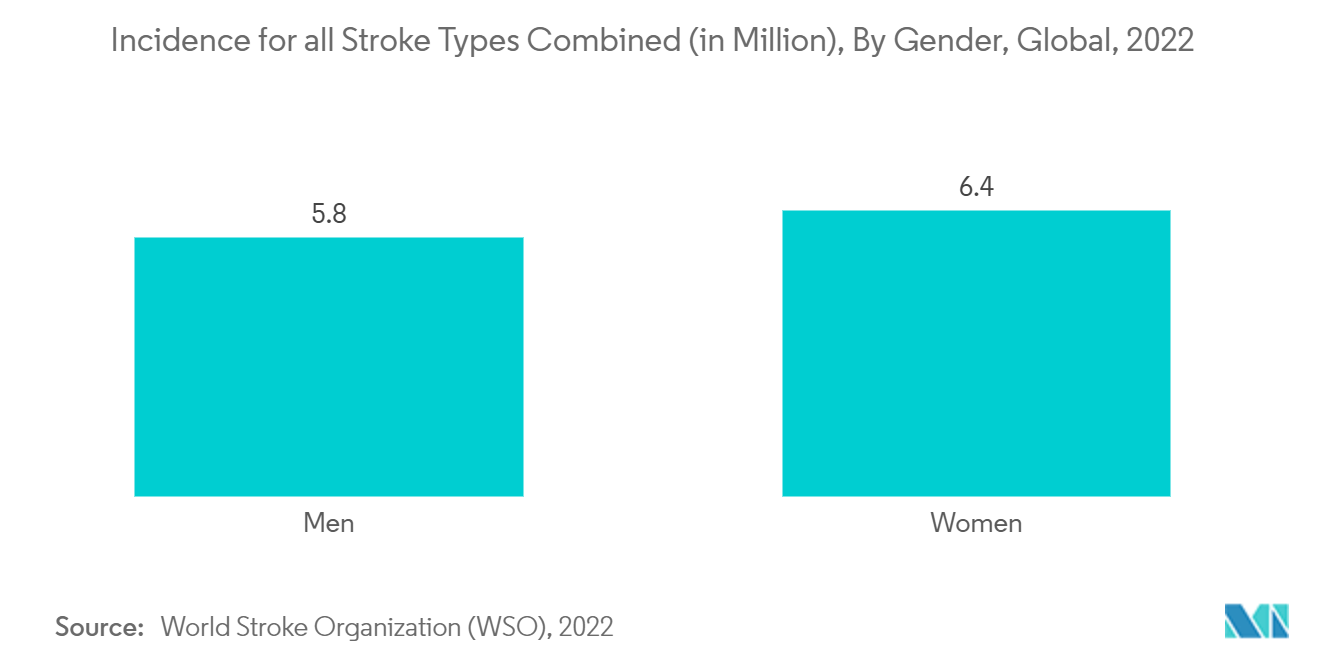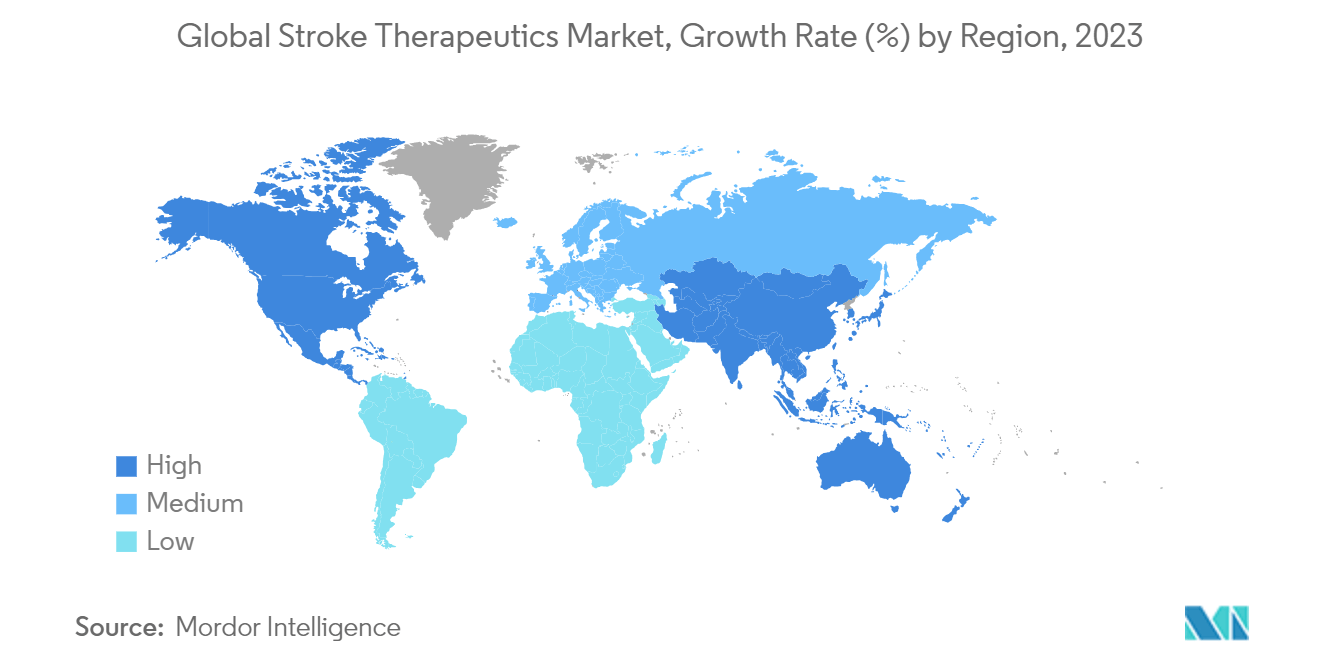Market Trends of Global Stroke Therapeutics Industry
Tissue Plasminogen Activators (TPA) Segment is Expected to Hold a Significant Market Share Over the Forecast Period
Tissue plasminogen activators (TPAs) have become essential in treating ischemic strokes. Approved as potent blood thinners, TPAs markedly boost patients' recovery chances. As the stroke therapeutics landscape shifts, TPAs like Activase and Tenecteplase are poised to command a substantial market share, bolstered by continuous clinical research and evolving treatment protocols.
According to the 2022 Factsheet from the World Stroke Organization (WSO), over 12.2 million new strokes are reported each year. Globally, one in four individuals aged 25 and older will likely experience a stroke in their lifetime. Consequently, the demand for treatments is expected to rise, indicating growth in the TPA segment.
Recombinant forms of TPA now stand as the primary treatment for ischemic stroke patients. Leading products, Activase (alteplase) and Tenecteplase (TNK), harness recombinant technology, boasting superior efficacy and safety. Research consistently highlights that timely TPA administration boosts recovery odds, cementing its role in acute stroke care. For instance, an October 2024 study in Neurology Journal revealed that TNK, at 0.25 mg/kg, matches TPA's safety but surpasses it in achieving optimal functional outcomes and reducing post-treatment disability. Such insights hint at a potential shift in clinical preference towards TNK.
Evidence supporting the efficacy of TPA extends beyond just functional metrics. A study published in December 2023 in the Annals of Emergency Medicine highlighted the safety advantages of Tenecteplase. It demonstrated that Tenecteplase resulted in lower mortality rates and a decrease in intracranial hemorrhage incidents when compared to traditional treatments. This comprehensive study reinforced findings from previous randomized trials, emphasizing the operational advantages of TNK, such as rapid dosing and cost-effectiveness.
These insights hold significant importance for clinicians. Tenecteplase stands out as a leading contender for acute stroke treatment, given its reduced risk of severe blood loss and enhanced mortality rates. The increasing benefits of TNK in clinical environments indicate a shift in stroke management, prioritizing therapies that enhance recovery and minimize complications.
Thus, TPA with Tenecteplase at the forefront, are poised to dominate the stroke therapeutics arena, signaling a move towards safer, more effective treatments. Backed by solid clinical evidence, TPAs not only elevate recovery odds for ischemic stroke patients but also showcase a safety profile vital for widespread clinical acceptance.

North America Held a Maximum Share in the Market and Expected to Dominate the Market during the Forecast Period
North America's stroke therapeutics market is on the rise, driven by advanced research, innovative clinical trials, and a deeper understanding of stroke mechanisms. With stroke incidence rates climbing in the region, the demand for treatments is poised to grow. In June 2024, the Public Health Agency of Canada highlighted that in 2022, approximately 878,500 adults aged 20 and older suffered a stroke. While stroke symptoms manifest similarly across genders, Canadian men exhibit a higher prevalence.
Strokes, being a leading cause of long-term disabilities, have intensified the demand for effective treatments. This urgency has led both academic institutions and pharmaceutical companies to make significant investments in research and development.
For instance, in January 2024, the University of Georgia achieved a significant milestone with the FDA approving AB126 for Phase 1b/2a clinical trials. Targeting ischemic stroke patients, who represent roughly 87% of stroke cases, this development could redefine stroke therapy. The trials will first gauge AB126's safety and efficacy, potentially unlocking new treatment avenues for a demographic with limited options. A successful outcome could revolutionize stroke management, promising better recovery and outcomes.
In another noteworthy advancement, in September 2023, researchers from the National Institutes of Health (NIH) identified uric acid as a potential booster for recovery from acute ischemic strokes. Their findings, published in Science Translational Medicine, utilized advanced preclinical techniques usually reserved for human clinical studies. The NIH's Stroke Preclinical Assessment Network discovered that uric acid could lessen ischemic brain injuries in rodent models, suggesting a need for further investigation. This emerging acknowledgment of uric acid's therapeutic potential may pave the way for new clinical trials, expanding treatment options for stroke patients.
The emergence of innovative compounds like AB126, alongside the reevaluation of established agents such as uric acid, underscores the dynamic evolution of stroke therapies. Such advancements not only enrich the therapeutic arsenal but also attract heightened investments from pharmaceutical entities.
With ongoing research and a deepening understanding of stroke mechanisms, North America's stroke therapeutics market stands on the brink of a transformative journey, promising enhanced patient outcomes and addressing the urgent demand for effective stroke interventions.


